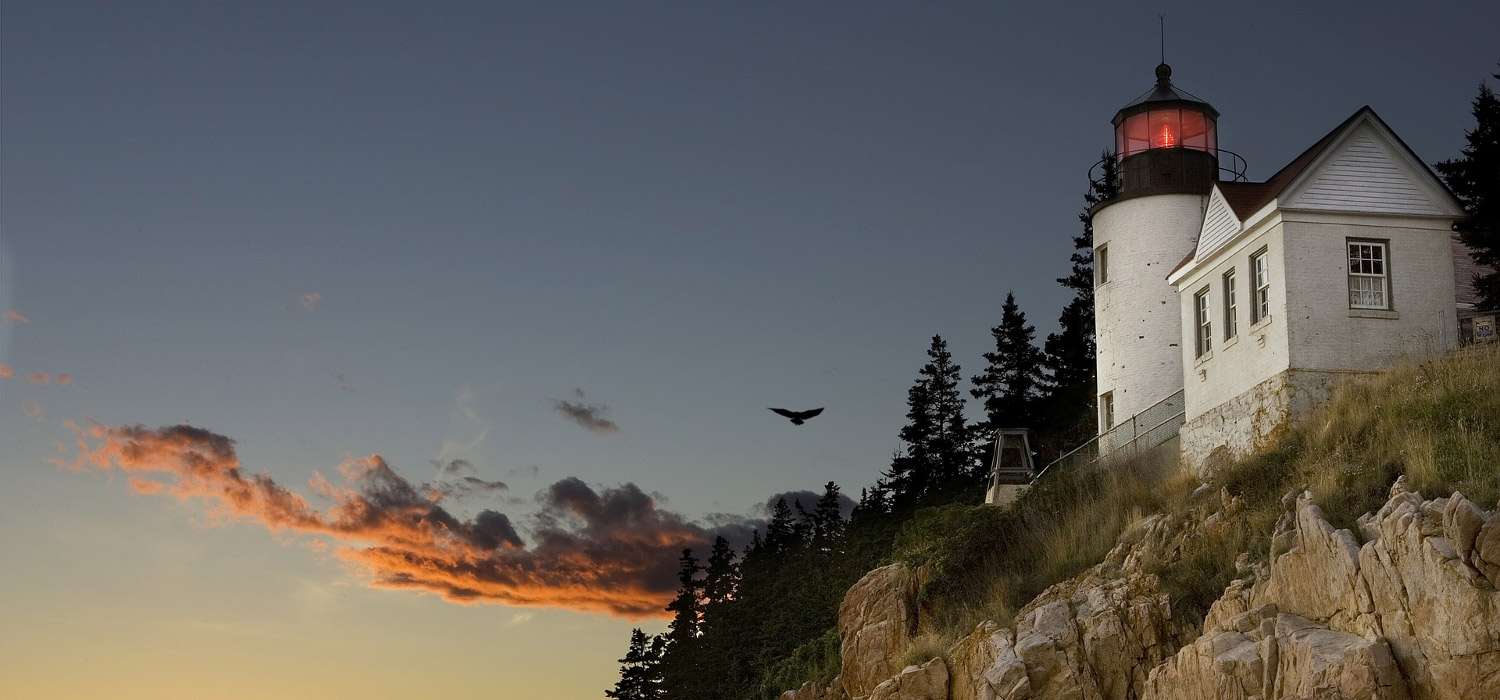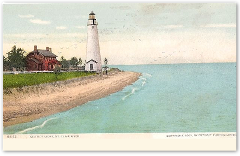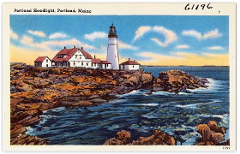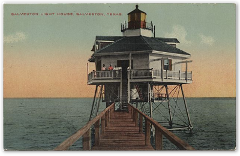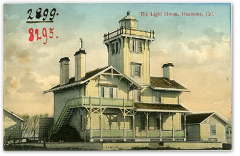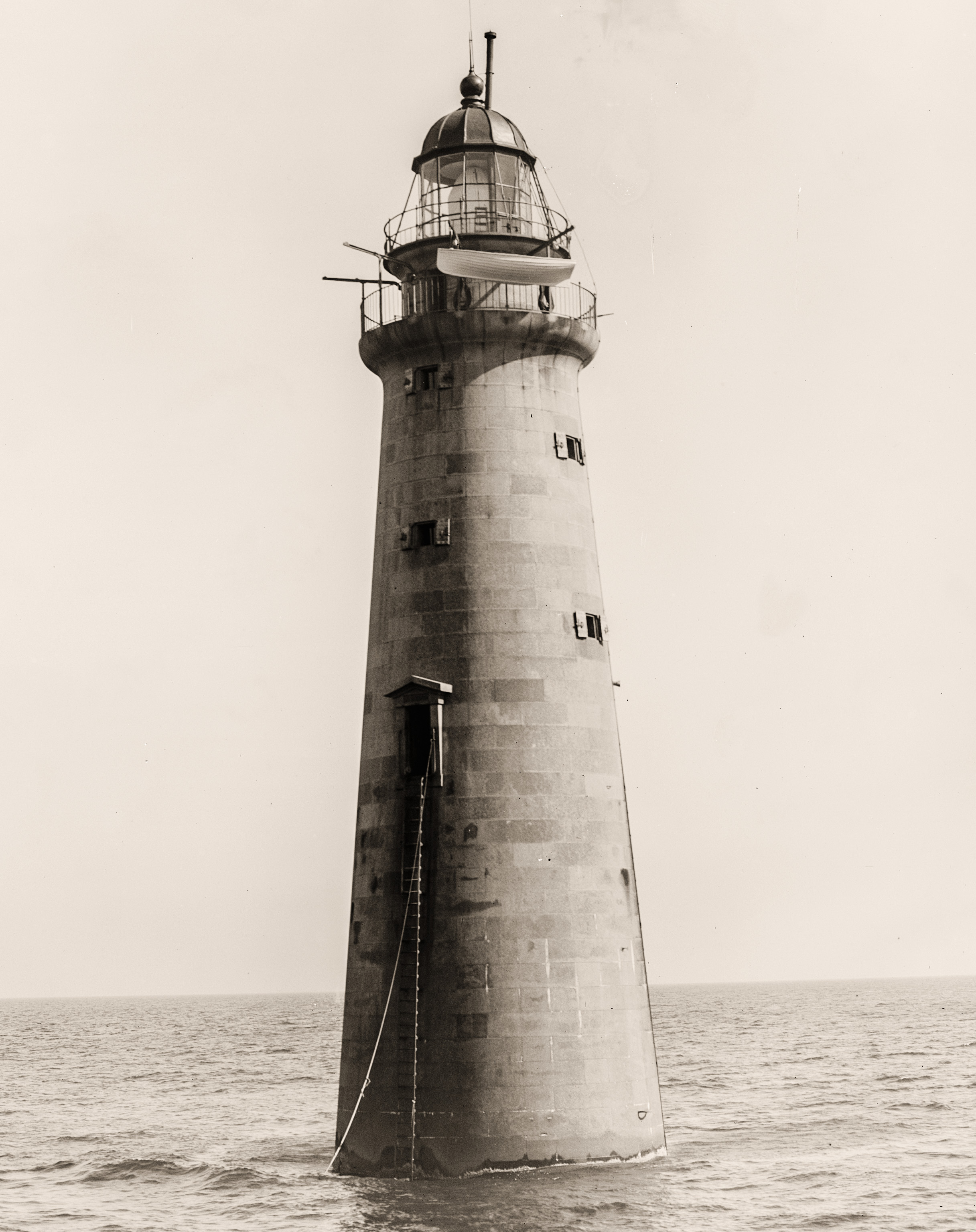COHASSET ROCKS
Station Established: 1850
Year Current/Last Tower(s) First Lit: 1860
Operational? YES
Automated? YES 1947
Deactivated: n/a
Foundation Materials: STONE LEDGE
Construction Materials: GRANITE
Tower Shape: CONICAL
Markings/Pattern: NATURAL
Relationship to Other Structure: SEPARATE
Original Lens: THIRD ORDER, FRESNEL 1860
Historical Information:
- Minots Ledge is one of the "Cohasset Rocks which had been the scene of countless wrecks since earliest times. Between 1832 and 1841 there were 40 wrecks on this and neighboring reefs. Between 1817 and 1847, it was estimated that 40 lives and $364,000 in property had been lost in shipwrecks in the vicinity of Minots Ledge, off Cohasset, Mass.
- In 1843, Inspector I. W. P. Lewis, of the Lighthouse Service, emphasized the great need for a lighthouse on Minots Ledge and his judgment was sustained by Capt. William H. Swift, of the United States Topographical Bureau, who recommended an iron-pile lighthouse as offering less resistance to the waves than a stone tower.
- The ledge was barely 20 feet wide and was exposed at low tide, being dry only 2 or 3 hours a day. On this narrow rock construction was begun in the spring of 1847 of a 75-foot open-work iron light structure. The men could only work on very calm days when the tide was at its ebb. The work was conducted from a schooner which remained near the ledge, unless the sea was rough, with the workmen sleeping on board. If a storm threatened, the schooner put into Cohasset Harbor until it was over.
- Nine holes were drillied into the solid rock, each 12 inches wide and 5 feet deep. Eight were placed in a circle, 25 feet in diameter, with the ninth in the center. Iron piling, 10 inches in diameter were then cemented into each hole. Four men worked in 20-minute shifts at the drilling from a triangle, set on heavy spars, which supported a platform high above the ledge, on which the drilling machinery was installed.
- All the apparatus was swept from the rock by two different storms in the summer of 1847. Workmen were swept into the sea several times, but none was drowned. Work had to be stopped for the winter in October 1847 and begun again in the spring of 1848, but by September of that year the nine holes had been drilled and the nine iron piles placed. The outer piles started toward the center to a 14-foot circumference, 38 feet above the uneven surface of the ledge. These were braced horizontally by iron rods at 19-foot intervals. Braces planned to strengthen the lower part of the tower were omitted on the theory that they would lessen rather than increase the over-all security of the edifice. However, it was where these braces were planned to go, that the structure actually broke off later.
- A cast-iron spider, or capping, weighing 5 tons was secured to the top of this piling. The keeper’s quarters were erected on top of this. Finally a 16-sided lantern room at the very top, housed a Fresnel lantern, with 15 reflectors. The light, a fixed beacon with an arc of 2100, was first lighted January 1, 1850.
- The first keeper, Isaac Dunham, was confident the light structure was not safe and wrote Washington requesting that it be strengthened. When no action resulted he resigned on October 7, 1850. Capt. John W. Bennett, who succeeded him openly scoffed at his predecessor’s fears. He hired new assistants including an Englishman named Joseph Wilson and a Portuguese named Joseph Antoine. Two keepers remained at the light at all times.
- The braces of the structure were soon showing signs of strain, however, and were constantly having to be removed, taken to the mainland and strengthened and straightened. A terrific northeast storm a few weeks after he took charge, changed Bennett’s mind and he officially reported the tower as in danger. A committee, delegated to investigate, arrived during a perfectly calm sea and returned to Boston, deciding nothing should be done.
- On March 16, 1851, during another terrible storm, the keepers deciding the lantern room was unsafe, retreated down into the store room, where they cowered for 4 days and nights, only occasionally climbing to the lantern to repair some damage done by the storm. The violent pitching and swaying of the tower almost knocked them off the rungs of the ladder, when they did. A relatively calm spell followed during which the braces were tightened.
- Then easterly winds began blowing around April 8, 1851. Bennett departed for the mainland 3 days later and this was the last time he saw his two assistants alive. When he sought to return next day, too heavy a sea was running at Minots Ledge to permit the attempt. The storm increased in fury and, by the 16th, was causing considerable damage ashore. At Minots Ledge, the two assistant keepers kept the bell ringing and the lamps burning, but just before midnight on the 16th they cast a bottle adrift containing a message for the outside world in case they failed to survive. The high tide at midnight sent wave after wave through the upper framework of the weakened structure. What actually happened then will never be known. Probably about 11 p.m. the central support snapped off completely, leaving the top-heavy 30-ton lantern tower held only by the outside piling. Then just before 1 a.m. on April 17, 1851, the great Minots Ledge Lighthouse finally slid over toward the sea. One by one the eight iron pilings broke until only three remained. The keepers, probably realizing that the end was near, began pounding furiously on the lighthouse bell. This was heard by residents of the Glades. With the tower bent over, the remaining supports now gave way and the great tower plunged into the ocean.
- The body of Joseph Antoine was washed ashore later at Nantasket. Joseph Wilson managed to reach Gull Rock, probably mistaking it for the mainland. Here he apparently died of exhaustion and exposure.
- Between 1851 and 1860 Minots Ledge was guarded by a lightship. Plans for a new stone edifice were meanwhile drawn up for the Lighthouse Board by Gen. Joseph B. Totten; model makers built the proposed new structure in miniature; the same location was decided upon; and Barton S. Alexander, of the United States Engineers, startedto work on its construction in April 1855.
- The ledge had to be cut down to receive the foundation stones and space was not available for a regular cofferdam. In June the old stumps of the first tower were removed. Meanwhile cutting and assembling of the granite was done on Government Island, near Cohasset. Seven granite blocks were to form the foundation. Permanent iron shafts, 20 feet high, were set in eight of the holes in which the old lighthouse piling had been, while the ninth or central hole was left open, to form a cavity for the base circle. Later a well for drinking water was built up from this cavity through the middle of the new tower.
- The framework structure disappeared during a severe storm on January 19, 1857, when the barque New Empire, which later went ashore at White Head, struck the temporary tower and demolished the iron scaffolding. So in the spring of 1857 the work had to be started all over again.
- The first stone was finally laid July 9, 1857. Temporary cofferdams were constructed from sand bags, so that the foundation blocks, laid more than 2 feet under the surface of the lowest tide, could be cemented to the rock face of the ledge. Strap iron between the courses kept the 2-ton stones apart while the cement was hardening.
- The total appropriation of $330,000 was all spent, except a small surplus, in the construction. By the end of 1859, the thirty-second course, 62 feet above low water had been reached, and 377 actual crew working hours had been consumed. The final stone was laid June 29, 1860, the whole granite structure having thus taken 5 years to complete, lacking 1 day. The new lighthouse was finished by mid-August 1860 and the light first exhibited August 22, 1860. The light was not regularly shone, however, until November 15, 1860, when Joshua Wheeler, the new keeper, and two assistants entered upon their duties.
- The new stone tower has withstood every subsequent gale. The strongest waves cause nothing but a strong vibration. On some occasions the seas have actually swept over the top of the 97 foot structure with no more damage than that caused by a few leaky windows or a cracked lamp or two.
- On May 1, 1894, a new flashing lantern was installed, with the characteristic of a one-four-three flash, which lovers on shore soon found contained the same numerical count as the words "I love you." Minots Ledge has thus become known up and down the coast as the "Lover’s Light."
- The light was made automatic in 1947. Today its 45,000 candlepower light, 85 feet above water, can be seen for 15 miles.
Content provided by www.uscg.mil

